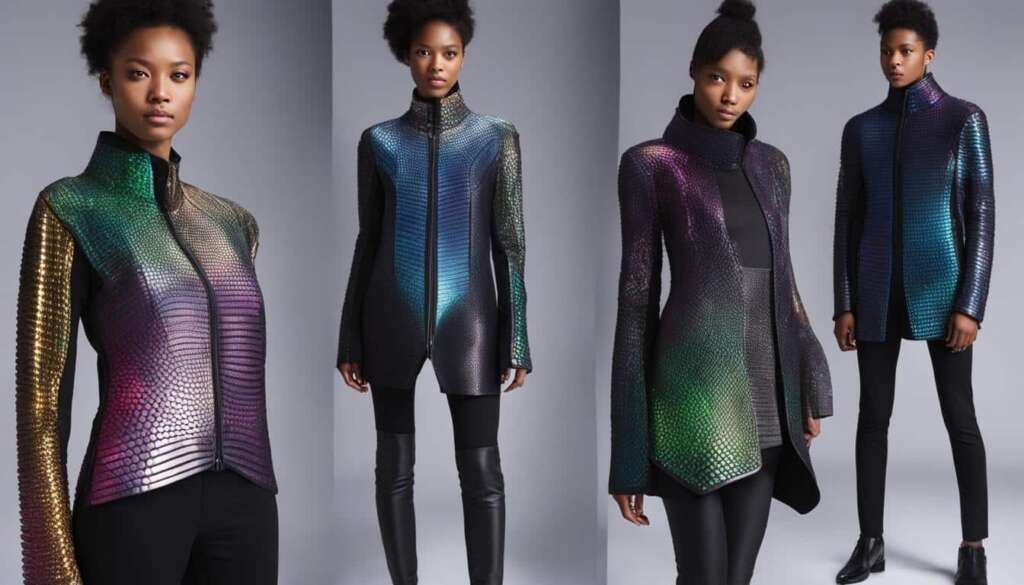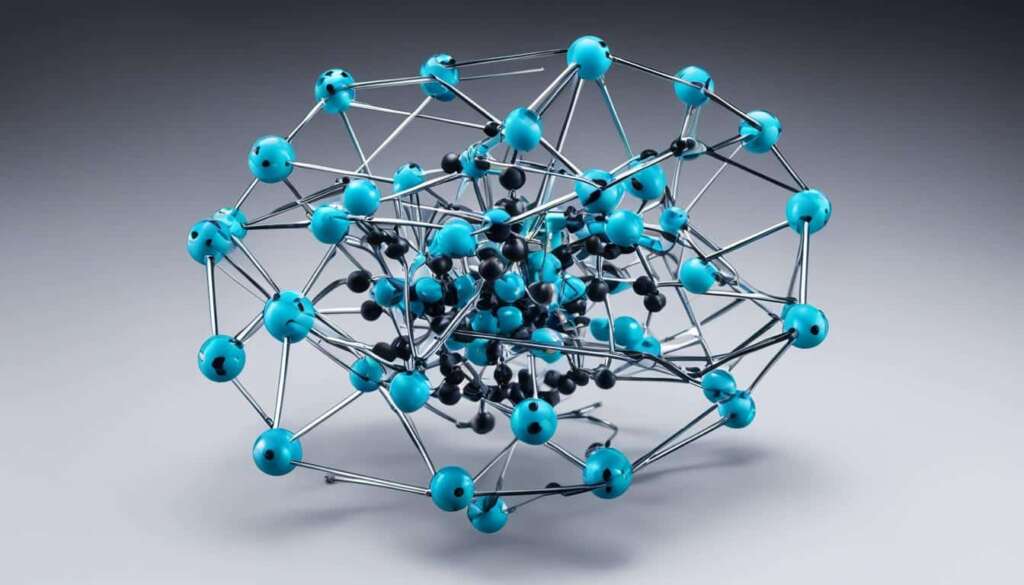Table of Contents
Nanotechnology is revolutionizing the fashion industry by introducing innovative clothing made with nano fibers and nanoparticles. These advancements in nanotechnology enable the creation of clothing with incredible properties, such as water resistance, stain resistance, odor control, and climate control. The demand for nanotechnology in fashion is driven by the need for sophisticated fabrics with exceptional comfort and special features. However, the use of nanomaterials in clothing also poses environmental risks that need to be addressed.
Key Takeaways:
- Nanotechnology in clothing offers properties such as water resistance, stain resistance, odor control, and climate control.
- The use of nanoadditives enhances fabric properties without compromising on weight, thickness, or flexibility.
- Antimicrobial nanosilver is used in sports clothing but poses environmental risks that need to be addressed.
- Nanotechnology enables the development of waterproof fabrics through hydrophobic nanofilaments.
- Nanotech clothing, such as ClimaWare, provides personal climate control capabilities.
The Use of Nanoadditives in Clothing
More and more companies are using nanoadditives to enhance the surface characteristics of clothes. These nanoadditives help improve fabric properties such as water and stain resistance, UV protection, wrinkle resistance, color durability, flame retardancy, and thermal performance. By incorporating nanoadditives at the atomic and molecular levels, clothing manufacturers can create fabrics with exceptional comfort and special features without compromising on weight, thickness, or flexibility.
Improved Fabric Properties
- Water and stain resistance
- UV protection
- Wrinkle resistance
- Color durability
- Flame retardancy
- Thermal performance
Nanoadditives play a vital role in enhancing these fabric properties, making clothing more functional and versatile. The use of these additives revolutionizes the traditional textile industry by offering advanced performance capabilities.
The incorporation of nanoadditives at the atomic and molecular levels allows clothing manufacturers to create fabrics that possess exceptional comfort and unique features.
One notable example of nanoadditive technology is the development of hydrophobic nanofilaments. These nanofilaments greatly enhance the water resistance of fabrics, making them ideal for outdoor clothing, swimwear, and athletic wear. The hydrophobic nature of these nanoadditives creates a protective coating on the fabric, preventing water from entering or penetrating the cloth, resulting in the fabric staying dry and comfortable even in wet conditions.
Additionally, nanoadditives can improve the UV protection of clothing, blocking harmful ultraviolet (UV) rays from the sun. This feature is especially beneficial for outdoor enthusiasts and those who spend extended periods outdoors. By incorporating UV-blocking nanoadditives into clothing, manufacturers can provide an extra layer of protection against the damaging effects of the sun.
Another noteworthy application of nanoadditives is in wrinkle resistance. By infusing textiles with these additives, clothing items can maintain a smooth appearance even after prolonged use or while being packed in suitcases. This feature is particularly beneficial for travelers and individuals who prefer low-maintenance clothing.
Additionally, nanoadditives enhance color durability, ensuring that clothing retains its vibrancy and does not fade easily. This feature is especially important for garments that need to maintain their appearance over time, such as uniforms or clothing used for sporting events.
Furthermore, the use of nanoadditives can enhance flame retardancy in fabrics. This additional property makes clothing safer by reducing the likelihood of the fabric igniting and promoting faster extinguishing of flames in case of accidents.
Thermal performance is another area where nanoadditives demonstrate their potential. By incorporating specific nanoadditives, clothing items can provide improved insulation, helping to regulate body temperature in different weather conditions. This feature is particularly useful in cold climates or for individuals engaging in outdoor activities.
In summary, the use of nanoadditives in clothing offers immense potential for improving fabric properties and enhancing the overall performance and functionality of garments. With advancements in nanotechnology, the possibilities for creating innovative and high-performance clothing are limitless.
Antimicrobial Nanosilver in Sports Clothing
Silver nanoparticles, known for their antimicrobial properties, are widely used in sports clothing to eliminate unpleasant odors caused by sweat. However, studies have shown that nanosilver can pose environmental risks. The concentration of silver ions in wastewater from washing clothes containing nanosilver can have long-term effects on soil ecosystems and aquatic organisms. The use of nanosilver in clothing also contributes to the depletion of limited natural resources. To mitigate these risks, it is suggested to limit the use of nanosilver in clothing or reduce the concentration of silver nanoparticles.
“The use of nanosilver in sports clothing has revolutionized the industry, providing users with odor-free garments. However, it’s important to consider the potential consequences on the environment. By adopting responsible practices, we can continue to enjoy the benefits of antimicrobial nanosilver without compromising our planet’s well-being.” – Dr. Emily Thompson, Environmental Scientist
The Environmental Risks of Nanosilver
The use of nanosilver in sports clothing raises concerns due to its potential impact on the environment. When clothes containing nanosilver are washed, a significant amount of silver ions can be released into wastewater. These silver ions can find their way into soil ecosystems and water bodies, where they can accumulate over time. The long-term exposure to elevated silver concentrations can disrupt the balance of ecosystems and harm aquatic organisms. Additionally, the extraction and production of nanosilver contribute to the depletion of natural resources.
Addressing the Environmental Risks
To minimize the environmental risks associated with nanosilver in sports clothing, several strategies can be implemented:
- Limiting the use of nanosilver: Manufacturers can explore alternative antimicrobial technologies that have less impact on the environment.
- Reducing silver nanoparticle concentration: Companies can adopt techniques to lower the concentration of silver nanoparticles in sports clothing without compromising their odor-fighting properties.
- Incorporating filtration systems: Wastewater treatment plants can implement filtration systems or other technologies to capture and remove silver ions from wastewater before it is discharged into the environment.
By implementing these measures, we can enjoy the benefits of antimicrobial nanosilver in sports clothing while minimizing its potential environmental impact.
Environmental Risks of Nanosilver in Sports Clothing
| Environmental Risks | Impacts |
|---|---|
| Soil ecosystem disruption | Long-term accumulation of silver ions can disrupt the balance of soil ecosystems, affecting microbial communities and nutrient cycling. |
| Aquatic organism harm | Elevated silver concentrations in water bodies can have toxic effects on aquatic organisms, damaging their health and populations. |
| Natural resource depletion | The extraction and production of nanosilver contribute to the depletion of limited natural resources, including silver. |
Waterproofing with Nanotechnology
Swiss chemists have developed a nanotechnology-based waterproof fabric that repels water. The fabric is made of polyester fibers coated with minute silicone nanofilaments. These nanofilaments have hydrophobic properties, forming a protective coating on the fabric that prevents water from entering or soaking the cloth. The fabric’s water-repellent effect is inspired by natural water-repellent surfaces like lotus leaves. This technology has potential applications in swimwear and athletic wear, offering enhanced performance and functionality.

| Advantages | Applications |
|---|---|
| Repels water, keeping clothing dry | – Swimwear |
| Prevents water from soaking into the fabric | – Athletic wear |
| Enhanced performance and functionality |
Inspired by nature
The innovative waterproof fabric technology draws inspiration from natural water-repellent surfaces found in lotus leaves. Mimicking the microstructure of lotus leaves, the hydrophobic nanofilaments create a protective barrier that prevents water from penetrating the fabric, keeping the wearer dry and comfortable.
“The fabric’s water-repellent effect is inspired by natural water-repellent surfaces like lotus leaves.”
Applications in swimwear and athletic wear
- Swimwear: The waterproof fabric technology offers exceptional water resistance, making it ideal for swimwear. It ensures that swimmers stay dry, allowing for improved performance and comfort in the water.
- Athletic wear: The hydrophobic nanofilaments repel water, preventing it from soaking into the fabric. This feature is particularly beneficial in athletic wear, where staying dry is essential for optimal performance and comfort during workouts and sports activities.
Personal Climate Control with Nanotech Clothing
An MIT student has developed a nanotech clothing line called ClimaWare, which revolutionizes personal climate control. The jackets, shoes, and helmets in the ClimaWare range utilize nanotechnology to act as personal air conditioners or heaters, providing innovative solutions to temperature regulation.
With ClimaWare, individuals can experience ultimate comfort regardless of the surrounding climate. The clothing items leverage the Peltier Effect, an advanced thermoelectric phenomenon, to create a cooling or heating effect. By passing electricity through the fabric, the ClimaWare garments can cool down to 17°C or generate heat up to approximately 40°C, providing the wearer with personalized climate control.
The applications of ClimaWare are diverse and far-reaching. The technology opens doors in various fields, including defense, healthcare, athletics, and personal climate control. Defense personnel can benefit from the ability to regulate body temperature amidst challenging environments, while healthcare providers can optimize patient comfort. Athletes can enhance their performance by maintaining an ideal temperature during training and competitions, ensuring peak physical conditions. Additionally, ClimaWare offers an innovative solution for individuals seeking personal climate control in everyday activities.
Furthermore, ongoing research aims to incorporate this cutting-edge technology into heating and cooling mechanisms for missiles, broadening the potential applications of nanotech clothing in defense and aerospace industries.
The Advantages of ClimaWare Nanotech Clothing
- Enables personal climate control
- Provides comfort in any climate
- Utilizes the Peltier Effect for temperature regulation
- Applications in defense, healthcare, athletics, and personal climate control
- Research on incorporating technology into heating/cooling mechanisms for missiles
With ClimaWare nanotech clothing, individuals can finally customize their personal climate regardless of the external weather conditions. This innovation paves the way for enhanced comfort, improved performance, and a more enjoyable experience in various aspects of life.
Lightweight Nano-Insulation for Clothing
Nanotechnology continues to push the boundaries of innovation in the fashion industry, with scientists now developing a groundbreaking form of lightweight nano-insulation for clothing. Traditional aerogels, while highly effective in space suits, were too fragile for everyday use. However, through the incorporation of strong and heat-resistant polymers, researchers have reinforced the structure of aerogel, making it more durable and suitable for various clothing applications.
This breakthrough in nano-insulation opens up a world of possibilities for designing “thermal” garments that offer exceptional heat retention, while also reducing the thickness of walls in refrigeration units. The lightweight nature of nano-insulation ensures that the clothing remains comfortable and flexible, without compromising on insulation capabilities. This has led to increased interest and potential use of nano-insulated clothing in a range of industries, including outdoor sports, military, and extreme weather conditions.
Advantages of Lightweight Nano-Insulation
- Superior insulation properties
- Reduced thickness and weight of garments
- Enhanced comfort and flexibility
- Improved heat retention
- Potential energy savings in refrigeration units
Not only does lightweight nano-insulation for clothing benefit individuals in extreme environments, but it also finds applications beyond Earth’s atmosphere. Space agencies are exploring the use of this advanced aerogel in next-generation spacesuits and inflatable heat shields for planetary atmospheres. The lightweight nature of nano-insulation is particularly advantageous in the field of space exploration as it allows for easier mobility and reduced weight constraints.

With ongoing research and development, lightweight nano-insulation in clothing holds the promise of revolutionizing how we experience and interact with our garments. It offers the potential for greater comfort, enhanced performance, and increased energy efficiency in various industries. As the demand for innovative materials in the fashion world continues to grow, lightweight nano-insulation is poised to play a significant role in shaping the future of clothing applications.
Environmental Concerns and Safer Nanotechnology
While nanotechnology offers exciting advancements in clothing, it also raises environmental concerns. The disposal of nanomaterials used in consumer products, such as clothing, can lead to uncertain waste routes and potential contamination of water systems. It is essential to conduct further research to understand the environmental impacts of nanotechnology and develop strategies to prevent pollution. By implementing safer nanotechnology practices, we can ensure the sustainable use of nanomaterials in the fashion industry and minimize any potential risks to the environment.
Innovative Applications of Nanotechnology in Clothing
Nanotechnology has revolutionized the clothing industry, opening up a world of innovative applications. By manipulating fabric properties at the atomic and molecular levels, nanotechnology has paved the way for extraordinary advancements in wearable fashion. From self-cleaning fabrics to intelligent clothing with climate control capabilities, nanotechnology has transformed the way we interact with our clothes.
Self-Cleaning Fabrics
One of the most exciting applications of nanotechnology in clothing is the development of self-cleaning fabrics. These fabrics are designed with a nano-coating that repels dirt and stains, making them incredibly easy to clean. The nanocoating creates a protective barrier on the fabric’s surface, preventing substances from penetrating and adhering to the material. As a result, clothes made from self-cleaning fabrics require less frequent washing and maintain their pristine appearance for longer periods.
Odor-Resistant Socks
Nanotechnology has also revolutionized the world of socks by introducing odor-resistant properties. By incorporating silver nanoparticles or other antimicrobial agents into the fabric, nanotechnology eliminates the bacteria and fungi responsible for causing unpleasant odors. This ensures that even during intense physical activities, such as sports or long-distance running, socks made with nanotechnology remain fresh and odor-free.
Intelligent Clothing with Climate Control
Imagine having clothing that adjusts to your body’s temperature and keeps you comfortable in any weather. Nanotechnology has made this possible with the development of intelligent clothing equipped with climate control capabilities. These garments are embedded with tiny sensors that detect changes in the body’s temperature and adjust the fabric’s properties accordingly. For example, when it’s cold outside, the fabric will trap heat and provide insulation, while in hot weather, it will allow for breathability to keep the body cool.
Fabrics with Enhanced Performance Properties
Nanotechnology has also enhanced the performance properties of fabrics, paving the way for new dimensions of design possibilities. By incorporating nanoadditives into the fabric, clothing manufacturers can create fabrics with enhanced durability, flexibility, and strength. Additionally, nanotechnology has enabled the development of fabrics with improved UV protection, moisture-wicking properties, and even wrinkle resistance. These advancements ensure that clothes made with nanotechnology not only look stylish but also perform exceptionally well.
As nanotechnology continues to advance, the possibilities for innovative applications in the clothing industry are endless. From self-cleaning fabrics to intelligent clothing with climate control capabilities, nanotechnology has transformed the way we think about fashion. By harnessing the power of nanotechnology, designers and manufacturers can create clothes that are not only fashionable but also functional, comfortable, and sustainable.
Nanotechnology Companies in the Fashion Industry
Several companies are at the forefront of incorporating nanotechnology into the fashion industry. Nano-Tex, Aspen Aerogel, BASF, and Nano-Horizons are key players in developing and commercializing nanotechnology-enabled textiles and fabrics with enhanced properties.
These nanotechnology companies specialize in creating innovative solutions that make fashion more sustainable, efficient, and clean. By harnessing the power of nanotechnology, they aim to revolutionize the way we produce and wear clothing.
Collaboration between fashion and technology companies is crucial for the advancement of nanotechnology in clothing. Together, they can explore new ideas, exchange expertise, and develop cutting-edge technologies that push the boundaries of fashion and textile production.
| Nanotechnology Companies |
|---|
| Nano-Tex |
| Aspen Aerogel |
| BASF |
| Nano-Horizons |
These nanotechnology companies are actively working towards creating a more sustainable and technologically advanced fashion industry. Through their innovations, they are shaping the future of clothing, making it more functional, comfortable, and environmentally friendly.

Potential Future Developments in Nanotechnology Clothes
The field of nanotechnology in clothing is continuously evolving, and we can expect future developments that will further enhance the functionality and performance of nanotechnology clothes. Researchers are diligently exploring new materials, improving manufacturing techniques, and addressing environmental concerns to push the boundaries of fashion tech.
Exploration of New Materials
Scientists and engineers are actively researching and experimenting with new materials that can be incorporated into nanotechnology clothes. These materials may offer enhanced properties such as increased durability, flexibility, and breathability. Carbon nanotubes, graphene, and conductive polymers are among the potential materials being investigated for their unique characteristics and potential applications in clothing.
Improvement of Manufacturing Techniques
In order to make nanotechnology clothes more accessible and cost-effective, researchers are working on improving manufacturing techniques. This includes developing scalable processes to produce nano-enhanced fabrics and garments more efficiently. Advances in nanofabrication technologies, such as molecular self-assembly and additive manufacturing, are enabling the production of complex nanostructures with precise control over their properties and performance.
Sustainability and Environmental Considerations
As the fashion industry increasingly focuses on sustainability, future developments in nanotechnology clothes will take into account environmental concerns. Researchers are exploring ways to reduce the environmental impact of nanomaterials used in clothing, such as developing eco-friendly fabrication methods, minimizing waste generation, and optimizing material recycling processes. These efforts aim to ensure that nanotechnology clothes are not only innovative but also environmentally responsible.
Integrated Smart Functions
The integration of nanotechnology into everyday clothing offers exciting possibilities for the future. Future developments may include wearable technology with embedded sensors and actuators, allowing for real-time monitoring of vital signs, environmental conditions, and even biometric data. Nanotechnology clothes may also incorporate energy-harvesting technologies, enabling self-powering or efficiency-improving functionalities.
“Future developments in nanotechnology clothes are expected to revolutionize the fashion industry and reshape our relationship with clothing. With the integration of innovative materials, advanced manufacturing techniques, and sustainable practices, nanotechnology clothes have the potential to offer unprecedented comfort, functionality, and style.”
In conclusion, the future of nanotechnology clothes holds great promise. Continued research and development in this field will lead to astonishing advancements, transforming fashion tech and setting new standards for the industry. As we look ahead, the immense potential of nanotechnology in clothing will undoubtedly shape the way we dress and interact with our garments, allowing us to experience fashion in ways we never imagined possible.
The Role of Nanotechnology in Sustainable Fashion
Nanotechnology plays a crucial role in advancing sustainable fashion. By developing clothing with enhanced durability, functionality, and performance, nanotechnology reduces the need for frequent replacement of garments, leading to a more sustainable use of resources. Additionally, nanotechnology enables the creation of eco-friendly fabrics with improved water and stain resistance, reducing the use of chemical treatments. The integration of nanotechnology in fashion can contribute to the development of a more environmentally conscious and responsible industry.
With nanotechnology, clothing can be designed to have a longer lifespan, reducing the environmental impact of the fashion industry. The use of nano fibers and nanoparticles in fabric production enhances the strength and resilience of garments, allowing them to withstand wear and tear for a prolonged period. This means that consumers can enjoy their favorite clothes for a longer time and reduce the frequency of purchases, ultimately reducing the amount of textile waste generated.
“Nanotechnology provides an innovative solution to the throwaway culture prevalent in the fashion industry. By creating garments with enhanced durability, we can reduce the need for constantly buying new clothes and minimize the environmental impact of textile production.” – Dr. Sarah Thompson, Nanotech Fashion Researcher
In addition to durability, nanotechnology offers opportunities to create eco-friendly fabrics that require fewer chemical treatments. Traditional methods of achieving water and stain resistance often involve the use of harmful chemicals that can have negative impacts on both human health and the environment. Nanotechnology provides an alternative approach by incorporating nanocoatings and nanoadditives that enhance the natural properties of the fabric without the need for excessive chemical treatments.
For example, by integrating hydrophobic nanofilaments into fabric, nanotechnology enables the creation of water-repellent clothing without relying on toxic chemicals. This not only reduces the environmental footprint of clothing production but also provides consumers with garments that are safer to wear and kinder to the planet.
Furthermore, nanotechnology can contribute to energy savings in clothing maintenance. By enhancing fabric properties such as odor control, nanotechnology reduces the need for frequent washing, which in turn conserves water and energy resources. This sustainable approach aligns with the growing demand for clothing that is both fashionable and environmentally responsible.
The sustainable benefits of nanotechnology extend beyond fabric production. The application of nanotechnology in the fashion industry also opens up possibilities for innovative renewable energy solutions. For example, research is underway to develop nanogenerators that can harvest energy from body movements, potentially powering wearable devices or reducing the reliance on external energy sources.
Overall, nanotechnology has the potential to revolutionize the fashion industry and make significant contributions to sustainable fashion. By developing clothing with enhanced durability, reducing the need for chemical treatments, and exploring renewable energy solutions, nanotechnology enables the creation of a more environmentally conscious and responsible fashion industry.
“The integration of nanotechnology in sustainable fashion represents a significant step towards a greener and more ethical industry. By embracing these technological advancements, the fashion world can demonstrate its commitment to the environment while offering consumers innovative and sustainable products.” – Jane Davis, Sustainable Fashion Advocate
| Nanotechnology Benefits for Sustainable Fashion | |
|---|---|
| Enhanced durability | Nanofiber reinforcement increases the lifespan of garments, reducing textile waste. |
| Eco-friendly fabrics | Nanocoatings and nanoadditives reduce chemical treatments for water and stain resistance, promoting safer and more sustainable fabric production. |
| Energy savings | Odor control properties reduce the need for frequent washing, conserving water and energy resources. |
| Innovative energy solutions | Nanogenerators can harness energy from body movements, offering potential renewable energy sources for wearable devices. |
Conclusion
Nanotechnology is transforming the fashion industry, bringing forth a new era of innovative clothing with enhanced properties. The emergence of nanotechnology clothes offers exciting possibilities for fashion tech, ranging from water-resistant and odour-free fabrics to personal climate control systems. However, it is imperative that we address the environmental impact associated with the use of nanomaterials in clothing and strive towards safer and more sustainable practices.
By harnessing the potential of nanotechnology and integrating it into fashion, we can reshape our relationship with clothing and pave the way for a more innovative and sustainable fashion industry. It is essential to acknowledge the importance of mitigating the environmental risks posed by nanomaterials and developing strategies that prioritize sustainability and pollution prevention.
Nanotechnology clothes have already begun to revolutionize the industry by offering superior performance and functionality. Moving forward, it is crucial to continue research efforts aimed at exploring new materials and manufacturing techniques to further enhance the functionality and durability of nanotechnology clothes. By doing so, we can create a more environmentally conscious and responsible fashion industry that embraces the transformative power of nanotechnology in shaping the future of fashion tech.
FAQ
How is nanotechnology revolutionizing the fashion industry?
Nanotechnology is revolutionizing the fashion industry by introducing innovative clothing made with nano fibers and nanoparticles. These advancements enable the creation of clothing with incredible properties such as water resistance, stain resistance, odor control, and climate control.
What are nanoadditives and how are they used in clothing?
Nanoadditives are substances at the atomic and molecular levels that are used to enhance fabric properties. They improve characteristics such as water and stain resistance, UV protection, wrinkle resistance, color durability, flame retardancy, and thermal performance.
What is the environmental impact of using nanosilver in sports clothing?
While silver nanoparticles have antimicrobial properties that help eliminate unpleasant odors in sports clothing, their use poses environmental risks. Wastewater from washing clothes containing nanosilver can have long-term effects on soil ecosystems and aquatic organisms, contributing to resource depletion.
How does nanotechnology enable waterproofing in clothing?
Nanotechnology enables waterproofing in clothing through the use of hydrophobic nanofilaments. These minute silicone filaments coat polyester fibers, forming a protective barrier that prevents water from entering or soaking the fabric, similar to natural water-repellent surfaces like lotus leaves.
Can nanotech clothing provide personal climate control?
Yes, nanotech clothing such as ClimaWare can act as personal air conditioners or heaters. By utilizing the Peltier Effect, electric currents passed through the fabric create a cooling or heating effect, offering customizable comfort in jackets, shoes, and helmets.
What is lightweight nano-insulation for clothing?
Lightweight nano-insulation for clothing is made possible through the use of aerogels. These advanced materials are reinforced with strong and heat-resistant polymers, making them durable and suitable for clothing applications. They offer enhanced thermal insulation and have applications in space suits and refrigeration units.
The disposal of nanomaterials used in clothing can lead to uncertain waste routes and potential water system contamination. Further research is needed to understand the environmental impacts of nanotechnology and develop pollution prevention strategies for its use in the fashion industry.
What are some innovative applications of nanotechnology in clothing?
Nanotechnology enables the development of self-cleaning fabrics, odor-resistant socks, intelligent clothing with climate control capabilities, and fabrics with enhanced performance properties. It allows for the manipulation of fabric properties at the atomic and molecular levels, opening up new design possibilities.
Which companies are leading the way in nanotechnology in the fashion industry?
Some key players in the field of nanotechnology-enabled textiles and fabrics in the fashion industry include Nano-Tex, Aspen Aerogel, BASF, and Nano-Horizons. These companies specialize in developing and commercializing nanotechnology-enabled fabrics with enhanced properties.
What can we expect in terms of future developments in nanotechnology clothes?
The field of nanotechnology in clothing is continuously evolving. Ongoing research efforts are focused on exploring new materials, improving manufacturing techniques, and addressing environmental concerns. This will lead to further enhancements in the functionality and performance of nanotechnology clothes.
How does nanotechnology contribute to sustainable fashion?
Nanotechnology plays a crucial role in advancing sustainable fashion by developing clothing with enhanced durability, functionality, and performance. This reduces the need for frequent garment replacements, leading to a more sustainable use of resources. Nanotechnology also enables the creation of eco-friendly fabrics with improved water and stain resistance, reducing the use of chemical treatments.
How is nanotechnology reshaping the fashion industry?
Nanotechnology is revolutionizing the fashion industry by introducing innovative clothing with enhanced properties. From water-resistant and odor-free fabrics to personal climate control systems, nanotechnology clothes offer exciting possibilities for the future of fashion tech. However, it is crucial to address the environmental risks and work towards safer and more sustainable practices.













